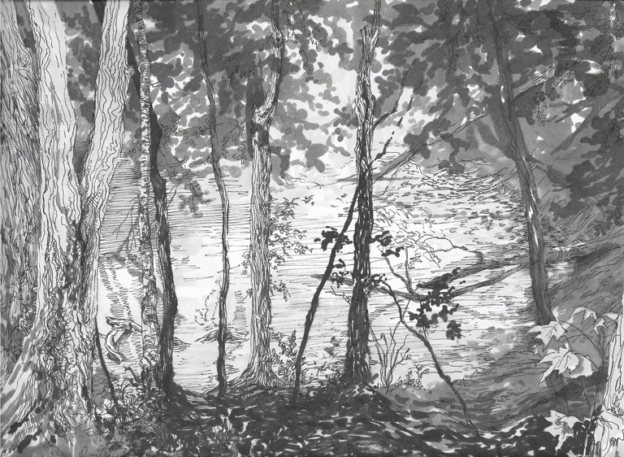This summer the Museum of American Bird Art is thrilled that Maris Van Vlack, a rising sophomore at the Rhode Island School of Design, will be interning at MABA. She will be sketching and painting in the wildlife sanctuary. She will be blogging about her experience. Enjoy her post about a week spent at the vernal pool. –Sean Kent

Many different kinds of birds live in the vernal pool area, making it a great bird watching spot! Below is a list of some of the most common species that I have seen there:
Baltimore Oriole– They are black and orange, so are easily seen in the trees above the vernal pool.
Northern Cardinal– the males are bright red, but the females are dull brown and camouflage well in the trees. I typically see them perched on branches that are low to the ground.
Mourning Dove– They are usually seen hopping about on the fallen tree near the back of the vernal pool (pictured below). I’m guessing that they have a nest in that area.

Black Capped Chickadee– They don’t have any bright colors, so they are harder to see. They are found anywhere in the trees or brush by the vernal pool.
Common Grackle– They appear to be completely black, but the feathers on their heads have a bluish iridescent quality. They are often in the mud by the edge of the water.

Grackles at the vernal pool foraging for food, watercolor
Of the birds that spend their time around the vernal pool, grackles are the most prominent because they make quite a lot of noise. They are omnivorous and hop around the vernal pool, looking for insects to eat. I decided that grackles were a good bird to draw because they are willing to get pretty close to me, unlike other birds who keep their distance and are obscured branches.
Drawing from life is a useful habit to form because it will help your drawings capture the movement and 3-dimensionality of your subject. When working on a painting of an animal like the grackle, which holds a position for just a few seconds at a time, I started by observing the bird and doing many quick sketches.

These drawings are all done from the observation of one grackle, which was hopping from branch to branch in the middle of the vernal pool. Each sketch took three to six seconds because I wanted to capture each position in the moment. I kept my eyes on the grackle, not on the paper, so I could draw the lines and shapes that I actually saw, and not the shapes that I remembered when I looked away. The goal of an exercise like this is not to create a beautiful finished drawing, but to quickly sketch as many gestures as I could. Some of my sketches don’t even look like birds! What they are meant to do is capture the shapes of a bird in motion. Here are a few things I learned while doing this exercise:
-You don’t just have to draw birds in profile, like so many drawings do. You can draw them straight-on, upside-down, from below, from above, sideways, flying, and more!
-There is a lot of movement in a bird’s tail. Sometimes it points up, other times it points down. When the grackle was turned sideways, the tail looked like a thin line, but when he turned backwards or was flying, it was fanned out.
-It is useful to draw a line representing the direction of the bird’s spine. It will help show the kind of movement that the bird is making, and will also help you draw the rest of the bird proportionally. This line is usually going to be curved like an S or a C, not a straight line.

This finished piece was painted with gouache. Gouache (it rhymes with squash) comes in small tubes and is very similar to watercolor. The main difference is that it is more opaque, so light colors can be painted over top of dark colors. As I was working on this painting, I was thinking about a dark color scheme that reminded me of the shadowy areas around the vernal pool. I reserved light colors for the highlights on the beak, eye, and parts of the branch. Even though the trees in the background contained a lot of bright yellow where the sun comes through the leaves, I chose to exclude those bright colors to keep the painting moody and dark. Adding little bits of red to the green paint keeps those shades from becoming too vibrant.

Birds are everywhere, so I encourage you to go outside and sketch one this week! Start with a practice exercise to capture basic shapes, and take a photo or two if you need help remembering the colors. Birds occur so often in art, and there is good reason! They have such a variety of colors, sizes, patterning, and shapes that they provide an endless list of possibilities for drawings and paintings.










